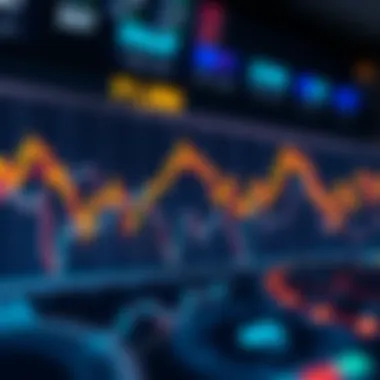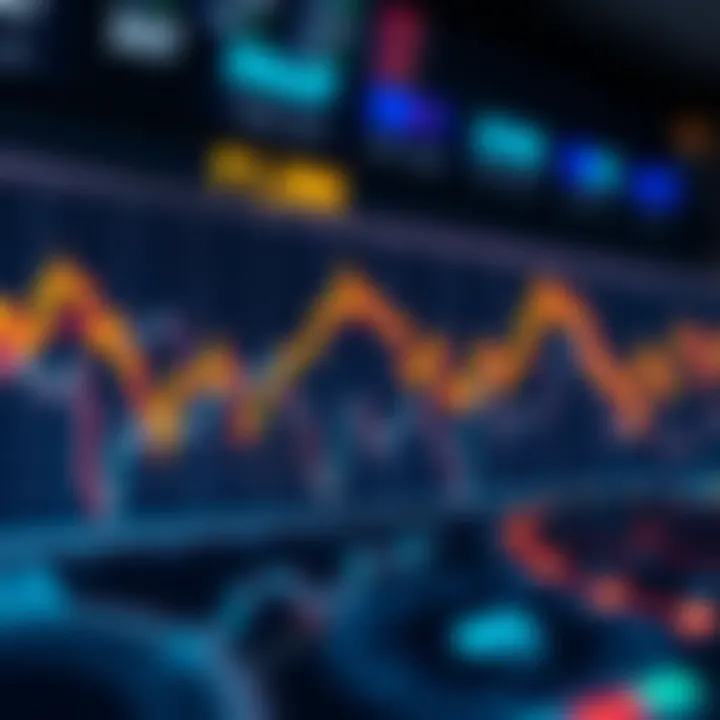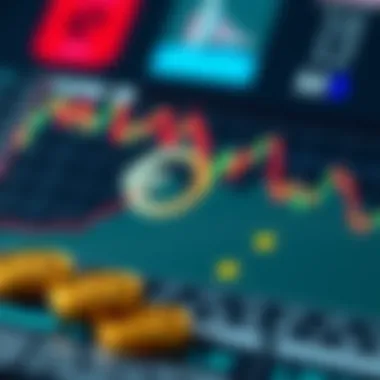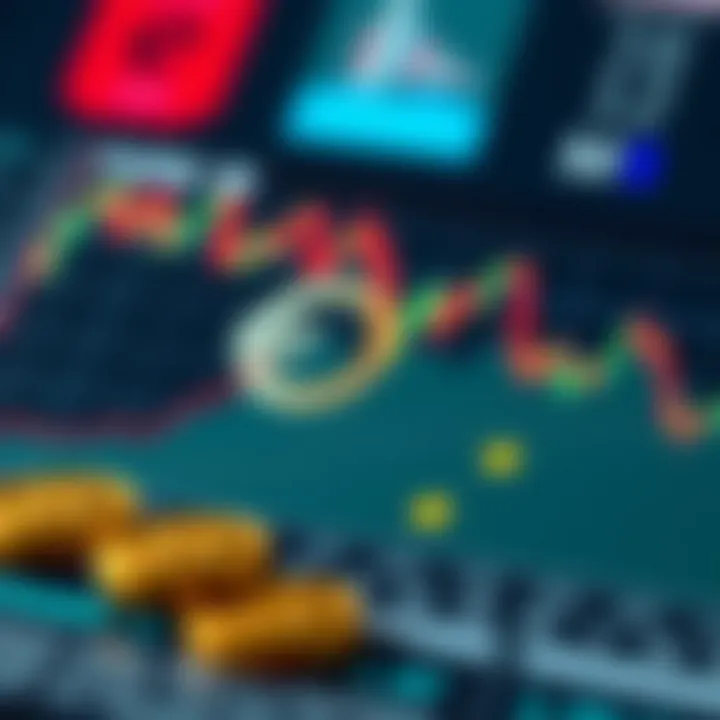Understanding EUR Futures: A Detailed Overview


Intro
The landscape of currency trading is not without its complexities, and EUR futures stand as a prime example of these intricacies. These futures contracts, products of the global financial market, play a pivotal role in managing risk and speculating on currency movements. As the euro continues to be a dominant currency, understanding how EUR futures work can provide both investors and traders with crucial insights into hedging strategies and market dynamics.
In essaence, EUR futures are agreements to buy or sell a specified amount of euros at a predetermined price on a set date in the future. The flexibility and utility of these contracts make them a cornerstone in the toolbox of many investors and hedgers. By trading EUR futures, one can mitigate the risks associated with currency fluctuations while also potentially profiting from favorable market movements.
In this guide, we'll take a detailed look at the operational mechanics of EUR futures, their role in the forex market, and the various factors influencing their pricing. This exploration aims to equip traders with a robust understanding of market trends, risks, and strategic approaches within the realm of EUR futures trading.
Preface to EUR Futures
Understanding EUR futures is vital for anyone engaged in the world of finance, particularly those interested in the foreign exchange market. As an instrument for hedging and speculation, EUR futures allow participants to manage risk associated with currency fluctuations. They are futures contracts that obligate the seller to deliver a set amount of euros at a predetermined price on a specified future date. This functionality makes them an essential tool in the arsenal of investors. Thus, gaining insight into their workings can enhance trading strategies significantly.
Definition of EUR Futures
EUR futures are financial contracts that represent an agreement to buy or sell euros at a future date, at a price established at the time of the contract's initiation. These contracts are standardized and traded on futures exchanges. Each contract typically involves a specific amount, usually 125,000 euros. They are used by various market participants, including hedgers looking to protect against adverse currency movements and speculators aiming to profit from fluctuations in currency rates.
Investors often utilize EUR futures for several reasons:
- Risk Management: Companies with international operations can hedge against currency risk tied to euro transactions.
- Leverage: Futures trading allows investors to control large amounts of currency with relatively low capital investment.
- Liquidity: The EUR futures market is robust and liquid, providing opportunities for quick entries and exits.
Historical Context
The EUR futures market was established in the late 1990s, coinciding with the launch of the euro as a common currency for many European nations. The launch facilitated significant changes in global currency trading. As the euro gained traction against the U.S. dollar, EUR futures began to emerge as a crucial tool for managing currency exposure.
Initially, interest in EUR futures was somewhat cautious as investors sought to assess the new currency's stability. However, as the euro established itself and the European Central Bank shaped monetary policies, the market began to thrive. By the early 2000s, trading volumes surged, reflecting increased participation from various financial institutions, companies, and individual investors.
Over time, numerous economic events, such as the European debt crisis and changes in U.S. federal policies, have significantly influenced EUR futures trading dynamics. Investors often look at these events to inform their strategies, leveraging historical data to predict future price movements.
In essence, the evolution of EUR futures is a reflection of broader economic trends and investor sentiment, underlining their importance as a financial instrument in today's global market.
Mechanics of EUR Futures Trading
Understanding the mechanics of EUR futures trading is crucial for anyone looking to navigate this complex financial landscape. It’s not just about buying and selling; the nuances of how futures contracts are structured, traded, and executed can make or break a trader’s experience. By grasping the core components of this trading mechanism, investors can position themselves strategically and harness the potential of currency markets.
Contract Specifications
The specifications of EUR futures contracts are foundational elements that dictate how these instruments operate. These contracts typically represent the future delivery of a specified amount of euros, commonly €100,000. Here are some key components:
- Contract Size: As mentioned, the standard size is often €100,000. This means that when you trade one contract, you’re essentially speculating on the future value of that amount of euros against another currency, typically the US dollar.
- Expiration Dates: Futures contracts have specific expiration dates, which can create a sense of urgency in trading. Contracts usually expire quarterly, so traders need to keep an eye on these dates to avoid futures rolling over unexpectedly.
- Tick Size and Value: The smallest incremental price movement that can occur is called the tick size. For EUR futures, this is often just 0.0001, which translates to a value of $10 per contract. Understanding these tick values can aid in gauging potential profits or losses.
Having a grasp of these specifications is essential for effectively managing risk and placing informed trades.
Trading Platforms
Choosing the right trading platform for EUR futures is equally important. Different platforms offer varying levels of functionality, fees, and user experience. A robust platform should provide:
- Real-time Data: Access to live market data allows traders to make informed decisions. Look for platforms that display price charts, historical data, and indicators.
- Risk Management Tools: Features such as stop-loss orders, limit orders, and other risk management tools can help safeguard investments. These functionalities are vital in volatile markets.
- User Interface: A platform that is intuitive can save time and reduce errors. Some traders may prefer a platform that offers advanced analytics, while others need something straightforward to avoid complications.
Some notable platforms for trading EUR futures include Thinkorswim, Interactive Brokers, and CME Direct. The choice of platform can significantly influence a trader's overall experience and efficacy in making trades.
Execution Process


The execution of EUR futures trades involves several critical steps that take place within a highly regulated environment. Here’s how it typically unfolds:
- Order Placement: After deciding to trade, the first step is entering an order on the chosen trading platform. Traders can place different types of orders (market, limit, stop), depending on their strategy.
- Order Matching: Once an order is placed, it goes to an exchange where it is matched with an opposing order. This happens in milliseconds, thanks to sophisticated technology.
- Confirmation: After the trade is executed, traders receive a confirmation detailing terms like the price, size, and time of transaction. It’s critical to review this confirmation to ensure everything aligns with expectations.
- Settlement: Most futures trades are closed before the expiration date, and settlement usually occurs at the end of trading for that specific contract.
Understanding the execution process demystifies how trading actually works and underlines the importance of precision in each step.
- Pro Tip: Staying educated about changes in trading rules and regulations can be advantageous, especially in a constantly evolving market. Refer to reputable sources like CME Group or Investopedia for reliable information.
Mastering the mechanics of EUR futures trading is crucial. It's an intricate balance of knowing the specifications, choosing the right platform, and executing orders efficiently. The more informed a trader is, the more successful they can be in this dynamic market.
The Role of EUR Futures in the Forex Market
The EUR futures market plays a critical role in the forex landscape, providing participants with tools to hedge against risk, speculate on price movements, and facilitate smoother capital flows. By understanding how EUR futures interact with currency valuation, traders can better navigate the complexities of global finance.
Impact on Currency Valuation
When it comes to the value of a currency, nothing holds more sway than the impact of futures trading. EUR futures, by their very nature, create expectations of future price movements. These expectations can profoundly influence currency valuation. For example, if traders anticipate a strong euro relative to the dollar, this positive sentiment is typically reflected in the pricing of EUR futures contracts. Conversely, negative outlooks generate bearish momentum, impacting the euro's strength.
In essence, market participants often use EUR futures as predictive indicators. Traders scan for early signs of shifts in market sentiment by analyzing contract pricing and volume. A rise in demand for EUR futures could signal bullish sentiment, while a downturn may indicate fears about the eurozone's economic performance.
Understanding these dynamics allows for better execution of trading strategies. Traders who keep a keen eye on EUR futures can position themselves to seize opportunities driven by fluctuating currency valuations.
Correlation with Other Markets
Another significant aspect of EUR futures is their interrelationship with other markets. The fortunes of the euro are intrinsically tied to various financial instruments: equities, commodities, and even emerging markets. For instance, if geopolitical unrest affects oil prices, it might simultaneously influence EUR futures. A surge in oil prices often leads to increased costs for the eurozone, affecting consumer spending and, consequently, the euro’s valuation.
Moreover, the correlation between EUR futures and interest rates cannot be overstated. As the European Central Bank (ECB) adjusts interest rates in response to economic data, the impact resonates throughout the financial system. For example, if the ECB hints at tightening monetary policy, it prompts traders to adjust their EUR futures positions accordingly.
"In today’s interconnected financial landscape, changes in one market can send shockwaves through another, making EUR futures a linchpin for traders looking to hedge against unexpected shifts."
Understanding these correlations enables traders to craft comprehensive strategies that take advantage of diverse market influences. Recognizing how changes in equities, commodities, or even sentiment in emerging markets can affect EUR futures helps establish a robust trading framework. It’s this interconnectedness that fosters a holistic approach among savvy traders, allowing them to anticipate shifts based on developments across financial landscapes.
Integrating knowledge about the impact of EUR futures on currency valuation and their correlation with other markets enhances one’s ability to make informed trading decisions. As the forex market continues to evolve, the role of EUR futures remains crucial.
Hedging with EUR Futures
In the vast ocean of financial instruments, hedging with EUR futures emerges as a lifeline for various market participants. It’s a strategy that enables traders to manage potential losses and safeguard profits against unfavorable currency fluctuations. The importance of hedging with EUR futures cannot be overstated, especially for businesses and investors operating in international markets where exchange rate volatility can affect the bottom line significantly.
• Protection Against Currency Risk: By engaging in EUR futures contracts, traders can effectively lock in exchange rates. This is particularly beneficial for companies importing or exporting goods, ensuring they don't get caught off guard by sudden shifts in the currency market.
• Cost Efficiency: Instead of using cash reserves to offset potential currency risk, businesses can utilize futures contracts with much lower capital outlay. This allows firms to allocate their resources more efficiently while still having a solid risk management response in place.
• Enhancing Portfolio Management: For investors, including EUR futures in their portfolios can create a balanced approach to risk. This enables them to diversify their investment strategies without being overly exposed to one particular market.
Risk Mitigation Strategies
When it comes to mitigating risks using EUR futures, there are several strategies traders can adopt. Each approach varies depending on the specific needs and circumstances of the market participant:
- Direct Hedge: This is the most straightforward method where an investor takes a position in EUR futures that is proportional to the amount of currency exposure they want to protect. For instance, if a company expects to receive payments in Euros, they might sell EUR futures to offset any potential drop in the Euro's value.
- Cross-Currency Hedge: In situations where businesses are exposed to multiple currencies, a cross-currency hedge using EUR futures can be useful. This involves hedging positions in different currencies simultaneously, reducing the overall risk exposure.
- Dynamic Hedging: This method entails adjusting hedge positions according to changing market conditions. For example, if the Euro begins to appreciate significantly, a trader may decide to reduce their hedge to capitalize on the favorable movement.
Adopting the right risk mitigation strategy with EUR futures can significantly influence a trader’s financial outcome. Being proactive and adaptable in response to currency market movements aids in preserving capital.


Examples of Hedging Scenarios
To illustrate how hedging using EUR futures works in practice, let's consider two scenarios involving different market participants:
- Manufacturing Company: A German manufacturing firm expects to export goods to the United States in six months and anticipates receiving payments in USD. However, due to market uncertainties, they fear that the Euro might strengthen, making their goods more expensive for American buyers. To hedge against this risk, the company sells EUR futures contracts equivalent to the expected amount they will receive. If the Euro does rise, their losses on the value of the currency will be offset by the gains on the futures contract.
- Investment Fund: An investment fund holding a portfolio of European stocks may worry about potential downturns in the Eurozone economy. To hedge against a decline in the value of Euro-denominated assets, the fund manager chooses to sell EUR futures. If the Euro weakens, the losses from the declining assets may be covered by the profits made from the sold futures contracts.
These scenarios highlight the practical applications of hedging with EUR futures. By assessing their position and executing appropriate futures contracts, both companies illustrate how protective strategies can effectively mitigate financial risks.
Speculating with EUR Futures
Speculating with EUR futures occupies a critical space in the trading world, especially for those looking to leverage fluctuations in currency value. Investors view these financial instruments as tools for truth-telling—offering a glimpse into future movements based on current data and trends. The real value lies in understanding how to navigate the nuanced market signals that can dictate success or failure.
The benefits of engaging with EUR futures extend far beyond the potential for profit. These contracts afford traders the agility to hedge against losses in other positions, essentially acting as a safety net or a way to balance portfolios. But there’s more: speculating on EUR futures enables investors to tap into macroeconomic trends, providing insights into the very heartbeat of the Eurozone economy.
However, speculation is not without its fair share of considerations. Traders must be prepared for the ebb and flow of market forces, which can swing on a dime based on new data releases or shifts in geopolitical dynamics. The key is to maintain a keen eye on the market landscape while being equipped with the right strategies for entry and exit points.
Strategies for Speculators
When wading into the waters of EUR futures, it's wise to have a game plan. Here are some strategies that can prove advantageous:
- Momentum Trading: This approach involves capitalizing on existing trends. Traders monitor price movements and jump in when momentum is evident, aiming to ride the wave of gains.
- News Trading: With economic indicators and geopolitical events directly influencing currency values, trading around significant news releases can provide unique opportunities. Being connected to sources of real-time economic news can be a game changer.
- Range Trading: This technique focuses on identifying stable price ranges for EUR futures. By determining support and resistance levels, speculators can make educated predictions about price movements within that range.
It's important for traders to have a flexible mindset. Markets are unpredictable; thus, a strategy that works today may not yield the same results tomorrow. Testing various approaches and adapting in real-time is crucial to staying ahead.
Analysis of Trend Patterns
To successfully speculate with EUR futures, keen analysis of trend patterns is essential. This analysis lays the foundation for informed decisions.
Traders often use several indicators, such as:
- Moving Averages: These smooth out price data to identify potential trends over specific periods, making it easier to spot upward or downward movements.
- Relative Strength Index (RSI): This momentum oscillator measures the speed and change of price movements. RSI values can help traders understand if EUR futures are overbought or oversold.
- Bollinger Bands: These bands encompass the moving average and indicate market volatility. When prices approach the upper or lower band, they often signify a potential trend reversal.
"Trend is your friend until it's not"—this saying encapsulates the essence of trading EUR futures. Understanding that trends can eventually reverse is vital for risk management. With the right tools and analysis techniques, speculators can position themselves to maximize profits while mitigating potential losses.
Factors Influencing EUR Futures Prices
To grasp the movements of EUR futures prices, one must understand that several factors play a pivotal role in shaping these financial instruments. Recognizing these influences not only aids traders and investors in making informed decisions but also sheds light on underlying market behaviors. Each element contributes to the complex interplay of demand and supply in the futures market, providing valuable insights for navigating this landscape effectively.
Economic Indicators
Economic indicators serve as the backbone of financial markets, including EUR futures. These statistics provide a snapshot of a country's economic health and influence investor expectations. Common indicators like GDP growth rates, unemployment figures, inflation rates, and consumer sentiment indices can sway the EUR futures market significantly. For example, when Germany releases robust GDP growth figures, it suggests a thriving economy, which often causes an uptick in the value of the Euro against other currencies.
Moreover, the European Central Bank (ECB) plays a crucial role in shaping expectations through monetary policy announcements. Changes in interest rates, asset purchasing programs, or inflation targets can send ripples across the EUR futures markets. Traders keep a close eye on the ECB meetings, often preparing for potential volatility surrounding the announcements.
Geopolitical Events
Geopolitical events can turn the tides for EUR futures prices almost overnight. Political stability, conflict, and international relations all have immediate consequences on currency valuation. Events such as Brexit negotiations, trade wars, or diplomatic conflicts directly impact investor confidence and risk appetite. For instance, uncertainty surrounding Italy’s political landscape historically causes fluctuations in Euro valuations, affecting EUR futures.
Furthermore, crises such as natural disasters or health pandemics also create a ripple effect in the futures markets. The COVID-19 pandemic, for instance, caused widespread concern and volatility. The consequent measures taken by governments and central banks are analyzed closely to forecast the market’s trajectory.
Market Sentiment


Market sentiment encapsulates the overall attitude of investors toward a particular currency or market trend. This psychological aspect can sometimes overshadow tangible factors, steering EUR futures prices in unexpected directions. When traders feel optimistic about the Eurozone's economic prospects, they may flock to buy EUR futures, pushing prices upward. Conversely, fear or uncertainty can lead to a sell-off that negatively influences futures prices.
Indicators of market sentiment often include trader positioning data, surveys like the ZEW Economic Sentiment, and overall trading volumes. A surge in short positions may indicate a bearish outlook, prompting cautious approaches among traders.
Understanding the nuances of market sentiment provides traders with a unique edge, as they can anticipate price movements based on collective psychological trends rather than just economic data.
In summary, the complex landscape of EUR futures is subject to multiple factors, including economic indicators, geopolitical events, and market sentiment. All three pillars interconnect and influence traders' perceptions, ultimately shaping the prices on the futures market. A keen understanding of these influences can empower traders to navigate the EUR futures market with confidence and foresight.
Risks Associated with EUR Futures Trading
When it comes to trading EUR futures, understanding the associated risks is crucial for both seasoned traders and those new to the field. These futures contracts can be a pivotal tool for hedging and speculating, but the inherent risks can’t be overlooked. Risk management isn’t just an option; it’s a necessity. In this section, we will delve into the main categories of risks associated with EUR futures trading, namely market risk, liquidity risk, and operational risk, providing insights that every trader should consider.
Market Risk
Market risk, often referred to as systematic risk, is perhaps the most omnipresent challenge faced by future traders. This refers to the potential financial loss due to unfavorable movements in exchange rates. With EUR futures, several macroeconomic factors can affect pricing, including interest rates, inflation, and geopolitical shifts. For example, a sudden policy change by the European Central Bank may lead to a rapid adjustment in the EUR/USD pair, influencing futures contracts significantly in a matter of hours.
Traders must stay informed about these factors. Understanding economic indicators, such as gross domestic product (GDP) growth, employment rates, and trade balances, can help investors brace for potential shocks in the market. Furthermore, utilizing tools like stop-loss orders can assist in managing this risk by limiting losses if the market moves against them. In a nutshell, while the market can be unpredictable, having a firm grasp of its nuances can tilt the odds slightly more in a trader's favor.
Liquidity Risk
Liquidity risk is another critical aspect of EUR futures trading. This risk arises when a trader is unable to buy or sell contracts in the market due to a lack of interested counterparties. When liquidity dries up, prices can become more volatile, making it hard for traders to exit positions without incurring substantial losses. In times of market stress, for instance during economic crises or unexpected events, the depth of the market may thin out, leading to wider bid-ask spreads.
It’s essential for traders to be aware of the liquidity of the specific futures contracts they are trading. Higher liquidity generally leads to more competitive pricing and better execution on trades. Traders may want to prioritize contracts that historically show higher trading volumes. Familiarizing oneself with well-performing futures exchanges can also be beneficial in mitigating this risk. Overall, understanding liquidity can save a trader from unforeseen dilemmas, as being able to enter or exit trades easily often dictates overall success in the trading realm.
Operational Risk
Operational risk refers to the potential losses that can arise from failures in internal processes, systems, or external events. This might encompass anything from technical failures in trading platforms to human errors in executing trades. In the fast-paced environment of futures trading, even minor disruptions can lead to substantial financial consequences.
For example, if a trading platform has a system failure during a volatile period, traders could miss out on advantageous trades or inadvertently incur losses. Implementing stringent protocols and checks can help mitigate such risks. Traders should also evaluate their technology and ensure it is reliable and fit for purpose. Regular updates and backups of trading systems can also provide a safety net.
"Being aware of the potential operational pitfalls in futures trading isn't just best practice; it's essential for protecting your investments."
In summary, being cognizant of the various risks tied to EUR futures trading is more than just a formality; it’s foundational. Grasping market and liquidity risks as well as ensuring solid operational procedures can empower traders to make informed decisions as they navigate the intricate landscape of futures trading. As the saying goes, forewarned is forearmed.
The Future of EUR Futures
The landscape of EUR futures is changing, shaped significantly by evolving global dynamics. In recent years, we've seen shifts in trading patterns, regulatory frameworks, and investor behaviors that indicate an essential transformation in how these futures are perceived and utilized in the market. Understanding the future of EUR futures involves looking at various elements that not only underscore their relevance but also highlight emerging opportunities and associated challenges.
Emerging Trends
The evolution of EUR futures is influenced heavily by current trends in the financial markets.
- Increased Automation: The rise of algorithmic trading is altering how futures are traded. Algorithms can react in real-time to market changes, bringing both speed and efficiency. Traders, inspired by the success of tech-based trading firms, now lean toward these automated systems. The ability to analyze vast amounts of data quickly allows traders to capitalize on minuscule price differentials that may arise.
- Growing Sustainability Awareness: With a surge in interest around sustainability, more investors are considering how their trading practices impact not only the financial landscape but also the environment. Financial instruments, including futures, are being evaluated through the lens of their long-term environmental effects. This growing awareness could steer the market toward more eco-friendly investment strategies.
- Focus on Regulatory Developments: As the market evolves, so does regulation. Historically, futures trading has faced varied scrutiny across jurisdictions. Keeping an eye on regulatory shifts is crucial for traders looking to navigate this complex landscape. Future regulations might create an environment that encourages greater participation while ensuring market integrity.
"In the volatile world of currency futures, adaptability is not just an advantage; it’s a necessity."
Technological Innovations
Technological advancements continue to redefine the trading experience in EUR futures, characterized by improvements that enhance efficiency and access.
- Blockchain Integration: One of the most significant innovations on the horizon is the integration of blockchain technology into futures trading. Blockchain can offer transparency, reduce settlement times, and even lower costs by facilitating direct trades without intermediaries. For EUR futures, this could mean smoother transactions and increased trust among participants.
- AI-Powered Analytics: As artificial intelligence technologies develop, their capacity to provide predictive insights grows. This progress could arm traders with tools to better anticipate market movements, analyze trends, and manage risks associated with EUR futures more adeptly. The ability to utilize AI for real-time data analysis represents a crucial leap forward in trading strategies.
- Enhanced User Interfaces: Trading platforms continue to evolve, offering more intuitive user experiences. These platforms enable both seasoned and new traders to make informed decisions quickly. The trend toward user-friendly interfaces makes EUR futures accessible to a broader spectrum of investors, including those who were previously intimidated by complex trading frameworks.
In summary, the future of EUR futures seems promising yet dynamic. It’s essential for traders and investors to stay abreast of these trends and innovations to harness the potential they offer and navigate the associated risks. As we head deeper into the 21st century, forex trading, especially EUR futures, is bound to be intricately intertwined with technological advancements and changing market sentiments.
For deeper insights on the future trends in futures trading, you can explore resources such as Investopedia and CME Group.
These insights emphasize the need for a continuously adaptive approach to trading in the EUR futures market. In this landscape, knowledge is not just power; it’s survival.



